Chapter 15. Comets: Origin, Orbits and Components
15.1 Introduction

Author: Kristen Miller
Editor: Grace L. Deming, University of Maryland
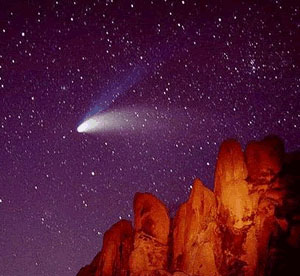
The goals of this module: After completing this exercise, you should be able to:
- Describe the origin of comets.
- Describe the orbital characteristics of comets.
- Name the components of a comet.
In this module you will explore:
- The characteristics of the parts of a comet.
- The composition of the main components of a comet.
- The formation of and differences between the ion and the dust tails.
Why you are doing it: Comets are beautiful and fascinating objects in the nighttime sky. You may have been lucky enough to observe a comet already like the one shown to the right that was visible in 1997. This comet was discovered as it approached the Sun after its orbit kept it in the frigid outer solar system for more than 4,000 years. Other comets like Halley's Comet are more regular visitors. The appearance of Halley's Comet was first recorded in 467 B.C. and it has returned regularly every 76 years. Studying comets has helped scientists understand the solar wind, the characteristics of highly eccentric orbits, and the composition of the early solar system.
15.2 Background
Comets are one of the most spectacular sightings in the nighttime sky. They have fascinated scientists, amateurs, and the general public. On rare occasion, they can be brighter than a full moon if the comet passes close enough to the Earth. Normally, darker skies are required to see a comet with its dramatic tails, which can stretch outward as long as the distance between the Earth and the Sun. There have been a few bright comets visible in recent decades.
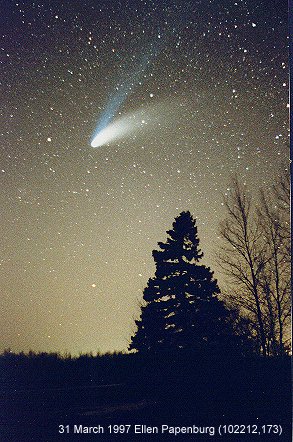
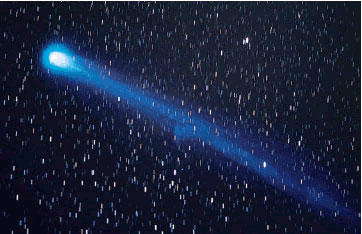
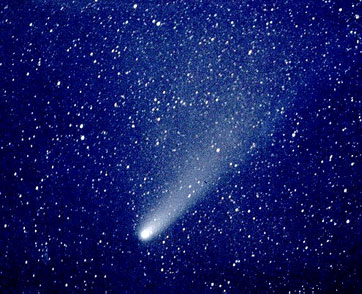
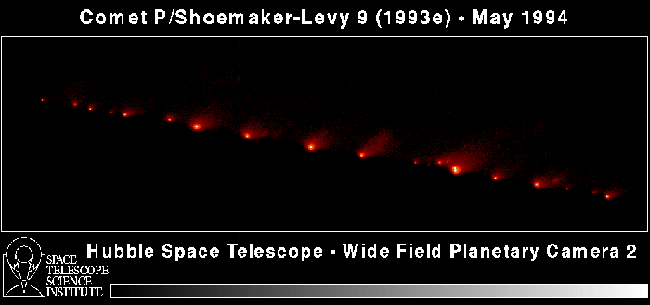
In this activity, you will explore the properties of comets and learn how comets create meteor showers visible on Earth.
15.3 Comets Basics

Comets originate in one of two places in our solar system: the Kuiper belt, which is the region located beyond the orbit of Neptune; and the Oort cloud, which is is presumed to be an enormous, spherical distribution of debris surrounding our solar system. Most comets travel on very elongated orbits with eccentricities close to 1. These highly eccentric orbits carry them from the far reaches of the solar system to the inner realms of the terrestrial planets, where they pass very close to the Sun. As they approach perihelion, comets are heated by the Sun and may become exceedingly bright. To understand why this happens, we must first study the parts of comets. Comets are composed of a nucleus, a coma, an ion tail, a dust tail, and a hydrogen envelope. The relative sizes of these are shown.

In the next few sections, we will look at each of these components in more detail.
Question 15.1
2xzTUVBbbj6ziwMrgYKc5ZalWx9pzQ/oMCmaPL/WARrrGh1u4VVffgMP0DDiQh9/RCqRbN99zRotthC8VVbHXcpYkOHC2SEKUjGW791wC2BwfonkFP4UiCuyzwsxrcnnBRFdkwVCEtIJvHODtLCD3gAJJBWKwmByiOBGkoUX89Mq2A7QKGsVLECg4Gf9Vo+Y1ZEFO0BskZcAtNM9NZhDkd2m/6jOD1uPL6zVCpBiWL7uQkLd5BLpAVJx2CB6PLWwOSoprFJlNBr4B7jcJtsEnicDQ29eSexc2bZ+BhclSJWyvkv9jk7FOQ==15.4 The Nucleus
When they are far from the Sun, comets consist of only a nucleus. The nucleus is typically about 10 kilometers (roughly 6 miles) in diameter. It is composed mainly of ices - water, methane, ammonia, and carbon dioxide ices - mixed with small rocky dust particles. This dusty ice mixture is bound together loosely, meaning that cometary nuclei are porous. The nucleus' small size, low temperature, and dusty component all cause comets to be very difficult to see until they are close to the Sun.
As a comet plunges into the plane of the solar system, it is warmed by the Sun's light. The ices, which make up its nucleus, begin to sublimate (change directly from a solid into a gas). Areas on the surface of the nucleus where the dust layer is thinner sublimate more rapidly, creating jets. The nucleus of Comet Halley was photographed in 1986 by the Giotto spacecraft. The nuclear jets can clearly be seen. The animation below uses data from Giotto to illustrate this process. Click on the "play" button to begin.
Question 15.2
p8+ueCV+FbxYPmK0TYli/ZELKxVm/AWnUHB9Roh73EpHvxm/0RJllkuUDsh+2ammmbXMJoAmTsqoIj8gJ+y2bDej0lks8wdq3H4EZpqXHILpkmuCTghGdnAM45cBmWkhYykGL7lrbB/ND5uCMMMCImuBkH7rOHhNt66nA55IVziupZ9W15.5 The Coma and Hydrogen Envelope
The jets of evaporating material that stream from the comet's nucleus as it nears the Sun form the coma and the hydrogen envelope of the comet. The coma is a luminous sphere of evaporated gas that glows as it absorbs energy from the Sun. It is the brightest part of the comet. The coma is typically 100,000 times larger than the nucleus, reaching sizes of one million kilometers in diameter. For comparison, the diameter of the Sun is about 1,391,000 kilometers; so a typical cometary coma extends roughly 75% the size of the Sun itself!

The hydrogen envelope of the comet is also produced from the gases, which sublimate from the nucleus as the comet nears the Sun. Hydrogen is produced as water ice in the nucleus sublimates and then absorbs solar ultraviolet radiation. The high energy radiation breaks the water molecule apart, releasing hydrogen. This sublimated hydrogen gas forms an enormous envelope around the comet's nucleus, typically ten times larger than the coma. The hydrogen envelope is not visible to the eye, but it can be observed at ultraviolet wavelengths as hydrogen atoms absorb and re-emit ultraviolet light from the Sun. The figure to the right shows two pictures of Comet Kohoutek, one in visible light and one at ultraviolet wavelengths. Notice how large the hydrogen envelope (which dominates the ultraviolet picture) is compared to the comet's coma (seen in the visible picture).
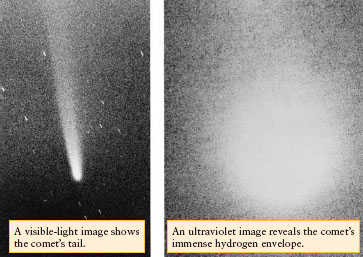
Question 15.3
9e77GsS24nwN22pp36zprptJiza9x/nNcPAR5W8FjAEo7utenJYqtzf7Vax5de1gRMuxfKQugi4OucAlCgNGERS+cs7Zqqw7NAtrO5avxbIA3+3/n/LqLTKq1Wk2I4zKExTPTsx+83kEBXZIJDAtab3aSvFx9R9gXPdxrwRClgk=15.6 The Tail
The tail of a comet is by far the largest component. Cometary tails can be more than one hundred million kilometers long, which means that they would be long enough to span the distance between the Earth and the Sun! Comets actually have two tails: an ion tail (shown as blue) and a dust tail (shown as white).
Click on the play button to observe both tails in the animation below.
Question Sequence
Question 15.4
wjaeMhDbF0HIUvdO08NFZCQmfcZAyI2O/RN5U/eaebDQROGQSz/dkOiA+Fny7nhKGLM2TmQw3f2lK64lNm2TCIXYRNwOeusBN2qi72xE/+7f1R20nWOICpmA/YJVFT876MkhcGvg06N4ZkNh351cpzvj1LgeAfWdIwy5ERcenoxvyu/dd0FwQVr0eaJbbd/5Vwq2F8Rz4wAFsHuLqllyGtd7v9BNGLpmJpl6mvFY87JrnlTxo+XMv2EkBWpUvSvdP76VLIO+znNv4JYf80BaPEHkt3C5Ezule7gvpMLVIJhLXVhSqs8hA7tQFXwHbIDc+YXjEkAOPeWKXP1xt8VqUt+kwICLbzW2mzD/U55NnQ9JtqCF/kMRUXRSEtbYLWguITcW00+7emqPa/78lbkfQ7M0F1QdvkNclTEfT8zAtuthR2CYMQTkvg==Question 15.5
DHEN9e/gGpKfGNxJKUBZT2aMaPZcx5ZD1ACeTUUlEsuKQPskf5uocrbC5ieSUKfKWjeTDwsIZqSIUg1uu4yDa8CgSU3VPTsDvMuUp4yKxtD8MXOz2RrY4bZEgEMmRh5YS5fzwuhOwX3TGlfKeQlIzi8uXMxNbhwMGXPYYA==Summary
The ion tail is formed as ionized gases from the coma are blown outward by the steady stream of particles ejected by the Sun, known as the solar wind. Consequently, the ion tail always points radially away from the Sun - the source of the solar wind. As you saw in the animation, this means that sometimes the tail leads the comet itself instead of always trailing behind it! The ion tail is distinctly blue because it contains carbon molecules like CN and C2, which have strong emission lines in the blue region of the visible spectrum.
The dust tail is formed from dust particles that are released as gases evaporate from the nucleus. Sunlight exerts pressure (this is known as radiation pressure) on the dust particles, carrying them away from the nucleus of the comet. The dust particles are larger and heavier than ions, so the solar wind is not strong enough to make the dust tail straight like the ion tail; instead, it is gently curved. Like the ion tail, the dust tail can lead the nucleus itself. The dust tail shines only by reflecting sunlight, so it appears white. Together, these two tails are a spectacular sight!
15.7 Quick Check Quiz
Indepth Activity: Comets: Origin, Orbits and Components